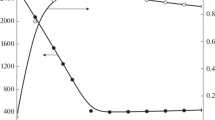Abstract
A new thermoanalytikal method, called electrothermal explosion (ETE) is described in which uniform heating of samples at extremely high rates (up to 105 deg. sec−1) is achieved. Heating is by direct passing of an electric current through the sample in the initial stages and by chemical heat release after the ignition conditions have been attained. ETE is the only direct method that allows the macrokinetics of heterogeneous reactions occurring in condensed systems to be studied at high temperature and at short conversion times, which are prohibitive for traditional thermoanalytical devices (up to 3500 K and 10−2 sec respectively).
Kinetic data on high-temperature, high-speed interactions in powder mixtures of carbon with titanium, silicon and tantalum are presented. The rate of heat release in the Ti−C system depends only to a small extent on temperature after the metal has melted, being mainly determined by the solution rate of carbon particles. The interaction mechanism in the Si−C system is similar to that in Ti−C, but the high enthalpy of carbon solution in liquid silicon results in a bulk activation energy ofE=55 kcal. mol−1. Synthesis of tantalum carbide from the elements in the temperature range 1500–3000 K occurs by the mechanism of reaction diffusion and proceeds with strong self-retardation.
Zusammenfassung
Unter der Bezeichnung elektrothermische Explosion (ETE) wird eine neue thermoanalytische Methode beschrieben, bei der ein gleichmäßiges Erhitzen der Probe bei äußerst hohen Geschwindigkeiten (bis zu 105 deg·s−1) erreicht wird. Das Erhitzen erfolgt im Primärschritt durch einen direkten Stromdurchfluß durch die Probe und nachdem die Zündungsbedingungen erreicht wurden, durch die Reaktionswärme. ETE ist die einzige direkte Methode, die die Untersuchung der Makrokinetik von heterogenen Reaktionen in kondensierten Systemen bei hohen Temperaturen und kurzen Umsatzgeschwindigkeiten erlaubt, was für übliche thermoanalytische Geräte (bis 3500 K und 10−2) unerreichbar ist.
In Anwendung der Methode werden kinetische Daten für Hochtemperatur-und Hochgeschwindigkeitswechselwirkungen in Pulvergemischen von Kohlenstoff mit Titan, Silizium und Tantal dargelegt. Die Geschwindigkeit der Wärmefreisetzung im Ti-C-System hängt, nachdem das Metall geschmolzen wurde, nur zu einem geringen Teil von der Temperatur ab und wird hauptsächlich durch die Lösungsgeschwindigkeit der Kohlenstoffpartikel bestimmt. Der Mechanismus der Wechselwirkung im Si-C-System ähnelt dem des Ti-C-Systemes, jedoch hat die hohe Lösungsenthalpie von Kohlenstoff in flüssigem Silizium eine Gesamtaktivierungsenergie vonE=55 kcal·mol−1 zur Folge. Die Synthese von Tantalcarbid aus den Elementen im Temperaturbereich 1500–3000 K erfolgt durch einen Mechanismus der Reaktionsdiffusion und verläuft mit starker Eigenverzögerung.
Similar content being viewed by others
References
N. P. Novikov, I. P. Borovinskaya and A. G. Merzhanov, Combustion Processes in Chemical Technology and Metallurgy (in Russian), Nauka, Moscow 1975, p. 174.
A. S. Shteinberg, V. V. Chervyakov and V. B. Ulybin, Abstracts of Proceedings of Second All-Union School-Seminar on Processes of Self-Propagating High-Temperature Synthesis (in Russian), Nauka, Moscow 1975.
V. A. Knyazik, A. G. Merzhanov and A. S. Shteinberg, Dokl. Akad. Nauk, 301 (1988) 899.
V. A. Knyazik, A. S. Shteinberg, Heat and Mass Exchange in Chemically Reacting Systems, Materials of International School-Seminar (in Russian), part 1, ITMO AS BSSR, Minsk, 1988, p. 143.
D. A. Frank-Kamenetskii, Diffusion and Heat Transfer in Chemical Kinetics (in Russian), Nauka, Moscow 1987 p. 296.
A. S. Shteinberg, V. V. Chervyakov and V. B. Ulybin. Thesis to the 2 seminar-school on SHS processes, Chernogolovka, 1975.
V. A. Knyazik, A. G. Merzhanov, V. B. Solomonov and A. S. Shteinberg, Fizika Gorenia i Vzrywa, 21 (1985) 69.
Author information
Authors and Affiliations
Rights and permissions
About this article
Cite this article
Knyazik, V.A., Shteinberg, A.S. & Gorovenko, V.I. Thermal analysis of high-speed high-temperature reactions of refractory carbide synthesis. Journal of Thermal Analysis 40, 363–371 (1993). https://doi.org/10.1007/BF02546588
Published:
Issue Date:
DOI: https://doi.org/10.1007/BF02546588




